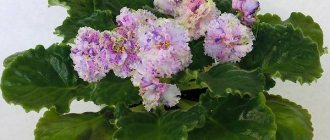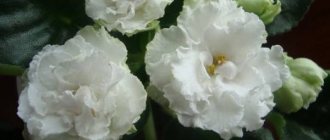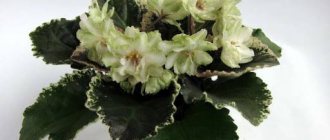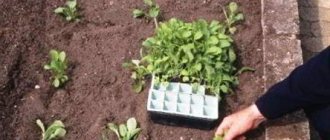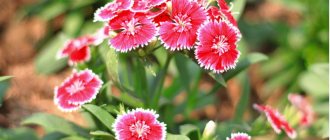Saintpaulias are one of the most popular indoor plants, and the number of varieties of this species is simply staggering .
Among them there are often similar in appearance and bearing completely different names, but there are also, on the contrary, not very similar with similar names.
bred by different breeders are a prime example of this . Below we will look in more detail at how the violet AB-Red Carnation and AB-White Carnation (Violet Plant), EK-Pink Carnation (E. Korshunova), LE-Neon Carnation (E. Lebetskaya) grow.
Each variety is unique and has its own characteristics in care and maintenance conditions . Compliance with which determines whether the color matches the varietal parameters, which is very important, especially for exhibitions.
Violet AB-Red Carnation: photo and description
Charming violet AB-Red Carnation.
AB-Red Carnation is an Uzambara violet, a genus of hybrid Saintpaulias belonging to the Gesneriev family. It was bred by a domestic breeder who goes by the pseudonym “Fialkovod” and all of whose varieties are signed with the capital letters AB before the name.
The bush is of standard size, the leaves are dark green , rounded with a heart-shaped base. The rosette is regular, but slightly inclined to lift the leaves upward. Flowers:
- Large;
- Terry;
- The color is rich red with a white border.
There are usually many peduncles and each has several flowers , so cap flowering is normal for this variety.
Important! With a strong increase in temperature and brightness of lighting, the white edging decreases and may disappear completely.
Care
variety is more unpretentious in care than other Saintpaulias:
- Watering and fertilizing:
- In the tray (under the leaves) - a pot or several are placed on the tray at once and water is added to the tray (under the leaves on the ground), after watering, the excess water is drained from the tray after 20 minutes. Watering frequency approximately: Once a week – in summer;
And once every one and a half to two weeks - in winter.
For fertilizing, use a concentration of fertilizers half that recommended , and fertilizing itself is carried out through watering, after about two weeks in summer and three to four in winter;
This variety needs to find suitable conditions.
- In summer – 22-24°C, daylight hours at least 12 hours;
Reviews
Victoria. “Very bright and fluffy beauty. The socket has formed correctly. The flowers pleased me from the third bloom; before that they were not so large and there was no cap of flowers. At first I couldn’t understand why there was no white border, but by reducing the brightness of the lighting before flowering and moving it a little to a cooler place, I got a beautiful, almost uniform border.”
Saintpaulia flowers resemble fluffy skirts.
Anna. “I was pleased with the purchased leaf with its quick rooting and three children at once. After the first flowering I was a little disappointed, the flowers were completely red, without a border and semi-double. I decided to wait a second time and did not regret it. The second bloom was capped, and the flowers were double and with a beautiful white border.”
Useful video
Watch the video to see what the AB-Red Carnation violet looks like:
Violet SM-Viburnum Red (Seedling Morev)
Gorgeous violet Viburnum Red.
History of the variety, who is the breeder?
Violet SM-Viburnum Red (K. Morev) is an Uzambara violet, which is part of the Gesneriev family .
The Uzambara violet SM-Kalina Krasnaya was bred by a domestic breeder of modern times, the favorite and most talented student of Boris Mikhailovich Makuni - Konstantin Morev. Konstantin has been breeding violets since 1994. His collection is different :
- Compact sockets;
- Lush and abundant flowering;
- Interesting color scheme and its diversity.
Photo and description of the variety
Violet SM-Viburnum Red standard rosette, the diameter of which is 30-40 cm. Violet flowers :
- Bright;
- Rich velvet red color;
- Resembling the color of wine;
- Along the edges of the petals there is a white and pink corrugated outline and a thin pencil green border.
The red color is very rich and may fade over time. All flowers may vary slightly :
- By shade;
- They do not bloom completely;
- When fully expanded, they have the shape of wavy stars.
The size of the flowers ranges from 4 to 6 cm. The largest flowers bloom first; as the cap blooms, the size of the flowers decreases to 4 cm. The rosette is even and forms independently. Sepolia leaves :
- Large;
- Rich green color;
- The stem is shortened;
- With a lack or excess of lighting, it tends to stretch.
Variegation, imprints
The leaves of the variety are rich green in color without variegation.
The variety has bright green leaves.
Violet Pink carnation (E. Korshunova)
EK-Pink carnation is a Saintpaulia bred by breeder E. Korshunova . This variety belongs to the genus of hybrid Saintpaulias, the Gesneriev family.
Delicate violet Pink carnation.
The rosette is large with fleshy, dark green leaves , slightly curled downwards. Flowers:
- Large;
- Semi-double and terry;
- Three to five are placed on each powerful peduncle.
There are many flower stalks, usually blooming in a cap or bouquet .
Care
The variety does not require special care .
Each Saintpaulia requires certain care.
| Irrigation type | In the tray (under the leaves) — flowerpots with plants are placed on a stand up to two cm deep. Water is poured into the tray (under the leaves). After watering, excess water is drained after 20-30 minutes. — The frequency of watering depends on the need (when the soil dries out) in the summer about once a week, in the winter – one and a half to two weeks. | Wick - a wick is placed in the pot, it is taken out through the drainage hole and placed in a container with water, which is placed under the flowerpot. — Water is constantly in the container. |
| Primer (recommended) | — Ready-made substrate for violets (Saintpaulia) is well suited for these types of watering. — The mixture can be made at home from peat, leaf soil, perlite and sphagnum moss in a ratio of 3/3/3/2. | — A mixture of peat and perlite in a ratio of 1/1. — Other types of soil are also suitable, but may become waterlogged with such watering. |
| Lighting and temperature | Summer – 22-24° C. Daylight hours should be more than 12 hours (bright lighting but without direct sunlight) | |
| Winter – 16-18° C. Daylight hours are about 8-10 hours. | ||
| Spring, autumn - the temperature changes gradually, as does the length of daylight hours. | ||
| Feeding | — Mineral fertilizers are applied through irrigation. About once every two weeks in the summer, and once every three to four weeks in the winter. — It is recommended to reduce the concentration by half from what is indicated in the instructions. | — Subcortex is constantly added to the water. — The concentration should be 7-8 times less than that recommended by the manufacturer. |
After proper care, Saintpaulia will reward you with good flowering.
Advice! By changing the temperature and brightness of the light, you can slightly change the color of the flowers, from pale pink to almost white in dark places and at low temperatures, and dark pink with plenty of light and rising temperatures.
Reviews
Christina. “I bought a leaf of the EK-Pink Carnation variety and received two babies at once. It’s good that I didn’t give one away and received two carved rosettes. From the first flowering, one of them went clearly according to the variety, pink, double, only the cap flowering turned out to be the third time. But the second one gave a beautiful sport, double flowers and very beautiful pink and white with a small light green border. In the second flowering, the color was repeated, and there were enough peduncles and buds for a cap.”
Olga. “I bought a blooming rosette of a beautiful violet pink carnation. With each subsequent flowering it produced a persistent bouquet and was pleasing to the eye. Unfortunately, the bush did not survive the hot summer, but the leaves rooted in the spring pleased several children at once, some of whom eventually became sports.”
Useful video
Find out in the video how the Pink Carnation violet blooms:
Features of flowering, growth and reproduction
Under good conditions, SM-Viburnum Red blooms all year round . When planting leaf cuttings, babies appear quickly, and after 2-3 months the grown babies can be separated from the mother leaf.
ATTENTION! Blooms with cap blooms when there is sufficient foliage. Doesn't like taking cuttings.
Saintpaulia will bloom well with proper care.
How long does it take to grow an adult plant?
From the moment the cuttings are planted, the flower blooms at full capacity after 11 months . And the children can produce flower stalks earlier, but after making sure that the variety is blooming, it is better to remove them, allowing the violet to gain enough strength for cap flowering.
Formation of buds in hot and cool conditions
The variety does not like sudden changes in room temperature. It feels optimal at 20-23 degrees . And at elevated temperatures, the green ruffle of the flowers disappears.
What do flower stalks look like?
Violet flower stalks:
- Tall;
- Longish;
- Gathered in the center;
- Each peduncle has from 3 to 6 buds.
With large flowers and abundant flowering, they may not support their weight and fall on the leaves.
Is it possible to achieve cap flowering?
In an adult rosette, the first flowering is immediately abundant. But very often one peduncle appears first, then after a few weeks the next one appears. And this is how a lush cap is formed, thanks to the long freshness of the flowers and the fact that all the flower stalks are collected in the center of the violet rosette.
Lifespan of one flower
The variety blooms for a very long time, from 3 to 10 months, expels the first flower , and then another and another. Each flower remains fresh for three weeks. The duration of flowering depends on the quality of care; if the plant receives a sufficient amount of nutrients, it blooms almost continuously.
ADVICE! During flowering, SM-Viburnum Red must be fed, since the flower spends a lot of vital energy on lush flowering and therefore needs feeding.
Violet AB-White Carnation
Saintpaulia AB-White Carnation was bred by a breeder under the pseudonym “Violet Grower” , all varieties of which are signed with the capital letters AB before the name of the variety. Uzambor violet belongs to the genus of hybrid Saintpaulias, the Gesneriev family.
Fantastic violet AB-White carnation.
Medium sized bush, leaves :
- Light green;
- Rounded;
- And they have a tendency to lengthen the petioles.
Flowers:
- Large;
- Strongly terry;
- White with a heavily ruffled pink border.
From one to three buds are formed on each peduncle ; there can be many peduncles and this ensures cap flowering.
Care
Attention! AB-White carnation is very sensitive to temperature and lighting.
Like all Saintpaulias, she prefers bright diffused light , without direct sunlight, but it is important not to overdo it with natural lighting, because this can lead to darkening of the flowers.
Daylight hours vary from 8-10 hours in winter to 12-14 hours in summer.
The temperature should be in the range of 16-24°C without sudden jumps, the lower limit is for the winter dormant period, and the upper limit is for summer and the flowering period; it is gradually changed in the off-season.
If the temperature rises excessively during flowering, the color of the flowers may change, as well as with an excess of light in the dark direction.
Each gardener chooses the type of watering for himself, and the choice of soil and fertilizer directly depends on this:
- To pallet – one or more individuals are placed on trays up to 2 cm deep. Water is poured into this container and the flower is allowed to drink for 20 minutes, after which the excess water is drained. With this type of watering:
- Fertilizers are applied once every two to three weeks;
The concentration of fertilizing is reduced by half from that recommended by the manufacturer.
- Under the leaves , water is added to the ground, the excess flows off and after a while it must be drained. The frequency and concentration of fertilizers, as well as the soil mixture, are similar to the previous option;
- Wick - place a wick in the pot, lower it into the lower, additional container through the drainage holes. The amount of fertilizer is calculated in proportion to 1/8 of the recommended dosage, and the plants are watered with this water constantly. For this type of irrigation, it is recommended to make a substrate of peat and perlite in a 1/1 ratio.
The soil is suitable ready-made for violets or a mixture of peat, perlite and leaf soil in equal proportions with the addition of sphagnum moss, the amount is adjusted depending on air humidity;
Reviews
Faith. “When buying a baby, I coveted the name White Carnation, I really love white Saintpaulias, when it bloomed I was a little disappointed, but also pleased at the same time. The positives were:
- Abundance of flowering (especially the first one);
- Evenness of the rosette (even with natural lightening);
- The splendor and elegance of flowers.
The downside for me was the pink border, although it is very beautiful and fits harmoniously, but I love pure white.”
Natalia. “I was pleasantly surprised by the first flowering of the starter I bought. The flowers are very large, double with a beautiful color that fully corresponds to the varietal characteristics. On the second flowering, the rosette pleased me even more, producing many peduncles and buds. After the flowers bloomed, it turned out to be a beautiful hat.”
Useful video
Find out in the video how the White Carnation violet grows: Watch the video how the White Carnation Saintpaulia develops:
Caring for a plant at home
Having chosen a suitable place for the Uzambara violet Viburnum Red, you need to think about regular care. In order for Saintpaulia Viburnum Red to decorate your home with lush blooms, you need to know the rules for caring for it - these are:
- Regular watering;
- Optimal temperature and humidity;
- And also do not forget to inspect the plant from time to time for the appearance of pests and to identify violet disease at an early stage, when you can still save the blooming beauty.
Proper watering and fertilizing
The plant loves slightly moist soil , so you need to make sure that it does not dry out completely. Young rosettes, like children, need to be watered more often than adults.
To optimize watering of violets, you can switch it to wick watering , so the soil moisture will always be the same. But in this case, the amount of baking powder in the substrate must be doubled and do not forget about nutritional supplements.
Frequent transplants will not solve the problem of lack of fertilizing, and the plant will become stressed and die from frequent changes of soil. There are three elements that should be regularly added to the soil, especially if the violet is young - these are:
- Potassium;
- Phosphorus;
- And nitrogen.
They will allow the plant to receive enough nutrients through the root system .
IMPORTANT! You cannot water the violet with cold water; such watering will cause brown spots to appear on the foliage.
Lighting and temperature
The variety loves natural light and does not like changes in room temperature . He is also very afraid of drafts. Under cool growing conditions, a green edge appears along the edge of the fringed petals.
In winter, violets require additional lighting.
Air humidity
Indoor air humidity is an important aspect when growing a variety. With insufficient humidity, the growth and development of the plant is inhibited and even the rosette can dry out the emerging buds.
And with excessive air humidity and too high a temperature, vascular bacteriosis very often develops , which instantly destroys the violet.
What kind of soil does he prefer?
The soil for growing should be:
- Nutritious;
- Breathable.
To do this, take high-moor peat, or special purchased soil for Saintpaulias , to which they add:
- Baking powder perlite;
- Vermiculite;
- Or foam balls.
IMPORTANT! The usual soil mixture from the garden is not suitable for violets.
Pruning and hygiene
To form a beautiful rosette, remove all asymmetrical and juvenile leaves. They also monitor the formation of stepsons in the leaf axils. All unnecessary stepsons are carefully removed while still tiny; a toothpick is great for this.
Violet Neon carnation (E. Lebetskaya)
LE-Neon carnation belongs to the Uzambor violets, a genus of hybrid Saintpaulias, of the Gesneriev family. The variety was recently bred by domestic breeder E. Lebetskaya.
Beautiful violet Neon carnation.
The rosette is compact and medium in size, but under certain circumstances it is prone to elongation of leaves . Flowers:
- Large;
- Semi-double with ruffled edge.
Saintpaulia color
- Deep pink;
- Close to fuccia;
- A white-light green border may appear along the edge.
Important! Usually it forms many peduncles and each has three to four buds, which ensures flowering in a cap.
Care
Neon carnation is no more demanding to care for than other varieties. Lighting should be plentiful but without direct sunlight. The temperature is maintained within 16-22°C in accordance with the season.
The soil is chosen at your own discretion, but it is recommended to use a ready-made substrate for Saintpaulia or a mixture:
- Peat/perlite/leaf soil/sphagnum moss in the proportion 1/1/1/0.5-0.8;
- And also peat/perlite in a 1/1 ratio (ideal for wick irrigation).
Watering is carried out in one of three ways :
- into a tray - into a container where pots with violets are pre-installed, up to 2 cm deep. After 20 minutes, the remaining water is drained. Fertilizers are applied through irrigation and the concentration is halved from that recommended by the manufacturer;
- Under the leaves - it is recommended to place the pots on pallets, and pour water onto the ground, avoiding contact with the leaves. After some time, excess water is drained from the pan. Fertilizers are applied as in the previous method;
- Wick - water is poured into a container, and a wick passed through the pot is lowered into it. Fertilizers are constantly added to the water, and their concentration is reduced by 7-8 times the recommended value.
Reviews
Many gardeners want to get this variety for themselves.
Catherine. “I bought a baby Neon Carnation. It grew quite slowly, but I think the problem is in the conditions of care, because all my flowers are very slow. The first flowering pleased me; the color was simply beautiful, rich and at the same time delicate. The border along the corrugated edge looks very impressive.”
Alina. “Unfortunately, the purchased rosette disappeared immediately after flowering. I really liked the color and shape of the flowers, as well as the shape of the rosette itself. The good news is that after the purchase I cut off a few extra sheets and decided to root them. Each gave from two to four children, and now I will have this beautiful flower.”
